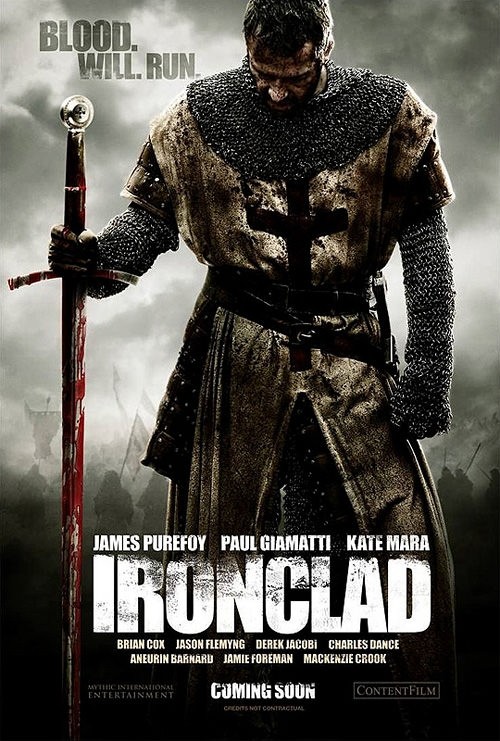 The 2011 film, ironclad (meaning covered, or protected with iron), takes place in the early thirteenth century after the writing of the Magna Carta, which limits the power of the king and grants rights to the freemen under the king. This film is based off of a battle that took place after King John signed Magna Carta. The film shows that John felt forced to agree with the ideas in Magna Carta and wanted to revoke his "signature", which is the beginning of a plethora or gruesome scene after gruesome scene which seem to play out very close to one another almost like you're playing a very bloody video game.
The 2011 film, ironclad (meaning covered, or protected with iron), takes place in the early thirteenth century after the writing of the Magna Carta, which limits the power of the king and grants rights to the freemen under the king. This film is based off of a battle that took place after King John signed Magna Carta. The film shows that John felt forced to agree with the ideas in Magna Carta and wanted to revoke his "signature", which is the beginning of a plethora or gruesome scene after gruesome scene which seem to play out very close to one another almost like you're playing a very bloody video game.While the idea of this movie is historically accurate, there are many aspects of the film that seemed to be out of place completely or slightly off. The battle that took place in order to protect Rochester Castle did in fact happen, however nearly everything portrayed in this film was incredibly romanticized, but how can you blame it? The film initially plays very heavy on the dirty, miserable peasant. It depicts many of them in a castle square, huddled up against a wall, shivering and soaking wet, covered in mud and filth. Obviously, from what we have learned about myths of the middle ages, hygiene was much more commonly practiced than typically thought and the common depiction of the dirty commoner is relatively inaccurate. Next, we had the representation of weaponry and armor. This seemed to be much more accurate, but there aren't typically any myths associated with this subject mostly because we have many artifacts to base our knowledge of medieval warfare off of. Knights and warriors wielded swords, halberds, bow and arrow, crossbow, shields, and wore armor we have discussed often in class like chain-mail hauberk.
Now on to some historical inaccuracies. After doing some research, the siege of Rochester Castle ended in a surrender by the rebels on November 30th, 1215, and only 6 months later did any backup come to aid the rebels in the form of Prince Louis. In the film, at the last second before the death of the last few rebels did Prince Louis swoop in and save the day, making the film much more exciting and suspenseful. Nobody likes a sad ending! Another bizarre factor of this movie was the random and pretty shallow romance. Within the few days this movie takes place, a Knights Templar who has broken his vow of silence in order to avenge his fallen abbot has also fallen in love with a woman named Isabel. There was basically no plot to the romantic aspect of this movie and it felt weird and forced, especially for the middle ages. Much of this movie, however, does feel very forced, or at least poorly supported by a thin plot. Yes it is loosely based on the siege of Rochester Castle but mainly the entire movie is fight scene after fight scene where blood spurts out of peoples bodies like a garden hose.
The movie Ironclad (2011) is yet another mediocre action movie loosely based on a historical event in the early thirteenth century and takes the love-making scenes more serious than the plot, and the fight scenes to a new level of gruesome. Many of the scenes depict common medieval myths discussed in class like the dirty, miserable peasant and very dark and colorless tone of the movie. I would not recommend this film as a means of learning historical events nor would I recommend this film as a good action movie unless you're willing to chalk up the $3.99 that YouTube asks of you to view this bloodbath of a movie.
Sources: Tunzelmann, Alex von. “Ironclad's Historical Credentials Are Made of Mulch.” The Guardian, Guardian News and Media, 12 Apr. 2012, https://www.theguardian.com/film/2012/apr/12/ironclad-credentials-mulch.







